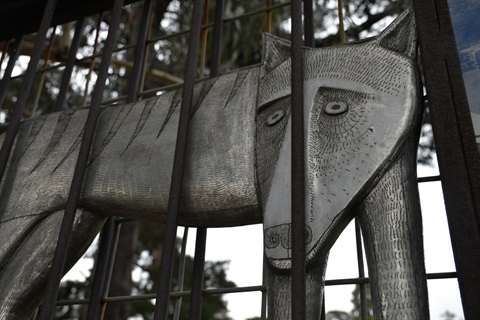100-year-old Beaumaris Zoo home to another threatened species
Published on 15 February 2023

The Beaumaris Zoo was the last known residence of a Tasmanian Tiger, but now it is home to another endangered native Tasmanian family – bandicoots.
February this year marks the 100th anniversary of the zoo’s opening on the Domain.
With the Domain a much loved and used destination for walkers, runners and bike riders, the zoo site has become a refuge for bandicoots in the area.
There is some irony in the last confirmed home of the now believed to be extinct Tasmanian Tiger has possibly become the home for another endangered animal, the eastern barred bandicoot.
Extinct in the wild on mainland Australia, Tasmania is now the stronghold for these tiny, shy creatures.
“Beaumaris Zoo was home to the last Tasmanian Tiger in captivity, and now it is a refuge to bandicoots that call the Domain home,” Acting Lord Mayor Helen Burnet said.
“It is heart-warming to see that hopefully the zoo can be part of the preservation of another striped Tasmanian, the eastern barred bandicoot.”
The death of the last Tiger at the zoo – September 7 – marks National Threatened Species Day.
Hobart Sustainability in Infrastructure Portfolio Chair Bill Harvey said the City of Hobart was playing its part in trying to ensure bandicoots did not join the Tigers in the pages of history.
“Hobart was the first capital city in Australia to declare a climate and biodiversity emergency and takes protecting wildlife seriously,” Cr Harvey said.
“The city’s Backyard Bandicoot project aims at helping Hobart residents assist in the bandicoot’s survival by providing tips on how to report sightings, keeping dogs and cats under control at night or walking your pet dog through bushlands.
“There are also tips and advice on how to create and maintain wildlife habitat in your garden, including planting native species that provide food and shelter for bandicoots.”
BACKGROUND
Hobart’s Beaumaris Zoo was operated by the City of Hobart at the Queen’s Domain for 14 years between February 1923 and November 1937, when a cycle of ill fortune and economic problems forced its closure.
Beaumaris Zoo started life in 1895 as a private collection of birds and animals at Beaumaris, the home of Mary Roberts (1841-1921) in Sandy Bay Road (near St Ive’s).
The new site of the zoo was chosen by its curator, Arthur Reid, and covered a 5½ acre parcel of land near Government House and the Royal Tasmanian Botanical Gardens.
A hundred years earlier, in the 1830s, convicts quarried sandstone from the site.
Following the completion of Government House in 1858 the quarry was virtually abandoned. Between 1891 and 1922 the site was a public park.
With the use of prison labour and seedlings germinated at the Botanical Gardens, the site was landscaped and planted with a combination of native species on the upper slopes while the lower slopes were planted with exotic trees.
Many of the larger trees which are currently located on the reserve relate back to this period of the site’s use.
The zoo has become famous as the last known home of the world’s largest marsupial carnivore - the Thylacine or Tasmanian Tiger.
Unfortunately, nothing now remains of that enclosure, though it is known that it was located at the top of the hill near the polar bear pit.
The last Thylacine held at the Zoo died on 7 September 1936 and its body was sent to the Museum. It was the last one known to exist in Tasmania.
In November 1937 the Zoo closed its doors and, as with its now most famous occupant, passed into Tasmanian history.